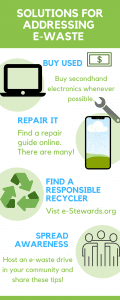Earlier this week, we shared a blog about the prevalence and dangers of e-waste, and how you can reduce and manage e-waste responsibly.

Besides re-using and repairing devices, responsible e-recycling is a common approach, however, not everyone knows how to do it or even that they can. Teachers can have a huge impact in spreading awareness about responsible e-recycling while engaging students in civic action and teaching valuable skills.
3 Reasons to Teach High School Students About E-Waste
1. It’s interdisciplinary and relates to many topics
Solving the e-waste crisis brings together many fields, from government to business to science – this makes it a relatively easy topic to integrate while also meeting your content standards. E-waste topics work well in classes on:
- Government and civics: What local, national, and international laws govern e-waste? How can people advocate for responsible e-waste recycling policies? Right now, 28 U.S. states have laws banning electronics from the trash, but there is no federal law banning e-waste. Some U.S. states have passed Extended Producer Responsibility (EPR) laws, requiring manufacturers to create or fund programs to recycle their products.
- Economics: How does supply and demand impact a product’s lifecycle and influence mass consumption? Which raw materials in phones are expected to increase in demand? Students can think critically about these topics and how they contribute to an e-waste crisis. This is a great blog post to introduce students to e-waste solutions and a circular economy.
- Science: What chemicals from e-waste impact the soil, air, and people’s health? What are the environmental and health implications from these chemicals?
- Engineering: How can we create ways to safely and responsibly recycle e-waste at scale? What are some prototypes that do this now? (Apple’s “Daisy” robot is one example, though on a very small and limited scale.)
2. Teaching about E-waste Can Inspire Meaningful Project-Based Learning

Schools are prime locations for e-waste production. As more affluent schools upgrade their technology for newer versions, e-waste mounts. If your school doesn’t have an e-waste recycling program in place, get your class involved in researching and starting one! Cartridges for Kids is a free recycling program that partners with schools and pays them for small electronics. You can check out the e-Stewards Initiative’s “Find a Recycler” page to find a responsible e-recycling center in your community.
Even if your school already e-recycles, your class can host an e-waste drive for the local community. Students can create flyers that spread awareness, and encourage their families and neighbors to drop off old gadgets.
Involving students with creating a solution is a great way to teach civic engagement, critical thinking, and teamwork. This is a great article about one teen in California who started an e-waste drive in his community.
3. Learning about E-waste Can Teach Students Global Citizenship
In our globalized world, students need the knowledge and skills to understand the wider world and how to find solutions to common global problems. Teaching about the origins and repercussions of e-waste shows students how their actions can impact both local and global communities and how to collaborate across fields to find effective solutions.
Next steps! Teaching About E-Waste in Your High School Classroom
Here are step-by-step instructions for an e-waste lesson. It would take approximately one 50-minute class period to complete (but more for the follow-up!).
Begin the class with a few bell ringer questions on e-waste to grab students’ attention. Ask students:
- What kind of technology do you or your family have? (A smart phone, TV, tablet, video game console?)
- When was the last time you or someone in your family received or bought a new phone or other tech gadget? Why was the item replaced? (Answers may include: it was old, it broke, it was slow, or they lost it.)
- Are there any tech gadgets you want to have? Why do you want them? (Answers may include: it’s faster, it has better camera, new features, etc.)
Now, ask students: What do they do with their old phones or devices? Do they throw them away? Leave them in a desk at home? Finally, ask students what they think the term “e-waste” means. Write down their responses on the board.
Next, introduce the 8-minute video “The Circuit: Tracking Down America’s E-Waste” from the Basal Action Network, which follows an undercover investigation of “recycled” e-waste that ends up shipped abroad, and the negative impacts this e-waste has on the local community. After the video, ask students if anything surprised them about what happens once we discard electronics. Do they think it’s fair that this e-waste is shipped overseas? Ask, what problems this might cause for the workers handling the discarded electronic waste?
 Finally, introduce Population Education’s case study reading about e-waste in Ghana – “Electronic Waste: The Case of Agbogloshie.” The reading is targeted for high school science and social studies classrooms, and is aligned with NGSS and Common Core Standards. Instruct students to read the case-study and then discuss the following questions in pairs:
Finally, introduce Population Education’s case study reading about e-waste in Ghana – “Electronic Waste: The Case of Agbogloshie.” The reading is targeted for high school science and social studies classrooms, and is aligned with NGSS and Common Core Standards. Instruct students to read the case-study and then discuss the following questions in pairs:
- Why do companies export their recycling to developing countries?
- What environmental and health problems does this cause for the community?
- What is the Basel Convention?
- Why is it hard to track e-waste?
- Whose responsibility is it to solve the e-waste crisis? (Businesses, manufacturing companies, governments, individuals, etc.) Answer: Everyone! Ask students: What part do you think each entity should play in creating solutions?
To wrap up the lesson, ask students to consider one way they could individually make a change that would lessen e-waste – keep a phone even when the new model comes out, choose a non-electronic alternative to a new gadget, etc. Each student should write down their idea and then explain how this change, if done on a larger scale, would impact the larger issue of global e-waste.
Follow-Up Activities on E-Waste
Following the lesson, you could ask students to conduct a community survey on tech consumption habits. They can talk to 5 people in their family, school, or community. Students will ask people “When was the last time you got a new phone?” “How long did you have the old phone?” “What did you do with the old phone?” “Do you know how to recycle your phone?” If no, students can hand them a resource list, similar to the one included at the bottom of this post. When class reconvenes, ask the class which response was the most common? Were you surprised by any answers?
Or students can do a research-based presentation as a follow-up. In small groups, students will investigate e-waste in their state or another country. Each group will choose a different location. Is e-waste increasing or decreasing? What policies are in place to manage e-waste hazards or prevent illegal exporting? How much e-waste does the country or state currently produce? What solutions are being implemented? Students can share their findings to the class.
More E-Waste Resources
- Find a responsible e-waste recycler with E-Stewards: e-stewards.org/find-a-recycler
- Checklist for creating an e-waste drive at school: www.treepeople.org/sites/default/files/pdf/resources/GE%20Ewaste%20Guide.pdf
- Global comparison: E-Waste Interactive Map and Country Fact Sheets: globalewaste.org/map
- Basel Action Network: www.ban.org
- Time Article: The World Has a Growing E-Waste Problem: time.com/5594380/world-electronic-waste-problem
- United Nations Global E-Waste Monitor Report: ewastemonitor.info
- A New Circular Vision for Electronics: Time for a Global Reboot: www3.weforum.org/docs/WEF_A_New_Circular_Vision_for_Electronics.pdf
Image credits:”Keyboards” by Daniel R. Blume is licensed under CC BY-SA 2.0; “The Circuit” screenshot (Basal Action Network via PBS)



